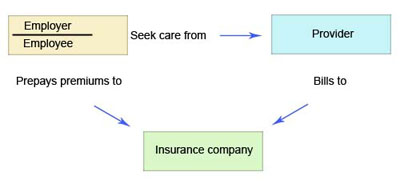When did third-party payments start?
According to M. Nowicki text book, third-party payments started back in the 1920s. Third-party payers come to play due to the fact that some first-parties (health care consumers) created bad-debt concerns because they couldn’t afford to pay the bills after the health related care and services were rendered to them. Everyone sought for the solution of the problem because if hospitals constantly do not receive payments they won’t be able to pay for their own obligations and needs. However, at that time there were more arguments against it than for third-party payers. Even though, those parties promised to cover most (if not all) cost on behalf of their clients, they made health care providers wait for payments of any medical bills. Physicians (second parties) wanted to get money right away; they didn’t want to wait for couple of months to get their money from insurance companies. However, the risk of not collecting anything at all from first parties (patients) creates the need for such type of protection anyway.
After many years of developing and improving health care laws in about the mid-1940s after World War II start to appear insurance companies that were independent from both the employer/employee and the provider. They shield both patients and health care providers and make huge influence in today’s health care industry development.
Figure 1: Commercial indemnity plans1

As any other type of organization, health care is a business that’s why they meant to work in order to make money. Medical care is a special type of organization, though, where peoples’ lives should be taken into account first before anything else or doing a business in particular. The social position and ethical issues turned health care services to be a basic human right.
Ethical issues associated with health care
On one hand, it is unethical to refuse providing medical services to people who need it, but can’t afford it. Moreover, some might even say that it is irresponsible for physicians and other health care providers to consider cost in a medical decision making process. However, on the other hand, the providers, as anyone else, cannot all the time work for free even though they would want to give all patients immediate and high-quality care they deserve.
Without money and financing any health care organization cease to exist and then it won’t be any hospital in the area that could treat people. That’s why there were all the time conflict of interests, controversies, and arguments between health care as a business and patients as human being. To try resolving this issues third-party payers came to play and they did solved some portion of the problem with low income, retired, and employed patients. However, they left behind those who do not go in any of these categories. Who are not too poor to qualify for Medicaid, not old enough to be eligible for Medicare, and whose employers cannot afford to offer health insurance coverage for their employees.
References:
1 The financial management of hospitals and healthcare organizations, fourth edition, Michael Nowicki
